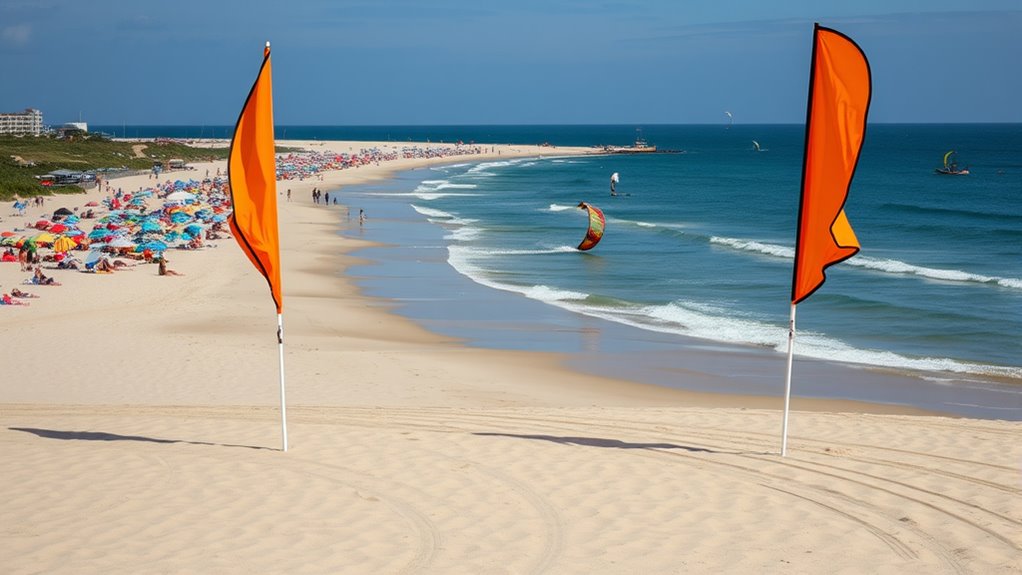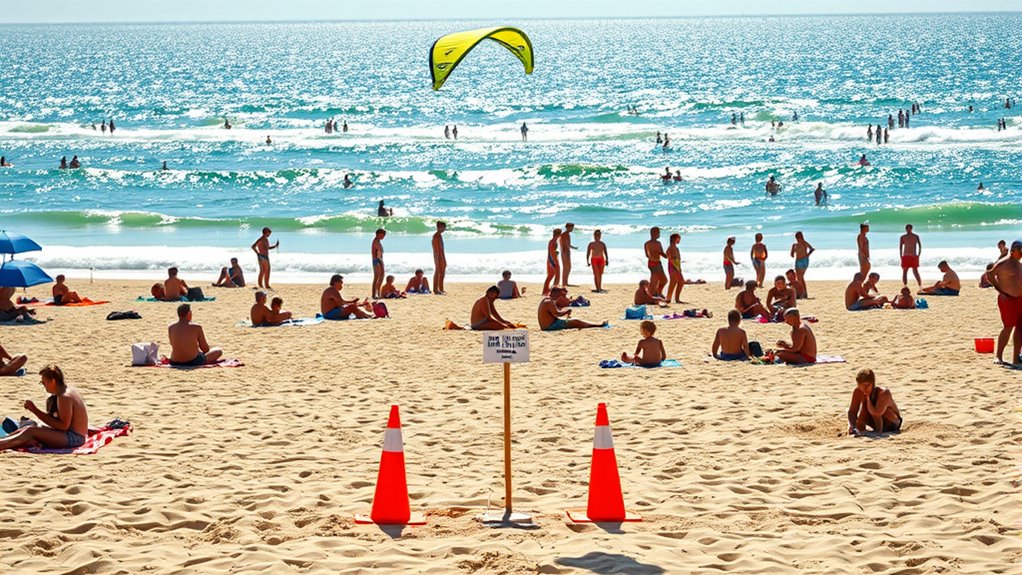To spot safe launch zones on crowded beaches, look for designated entry points away from swimmers and water sports. Choose areas with clear, open space free of rocks or vegetation, and guarantee good visibility for safety. Stay near monitored zones like lifeguard stations, and avoid launching over high traffic or unpredictable water activity. Keep beachgoers at a safe distance and stay aware of weather and tide conditions. Continuing further reveals additional tips to ensure your launch stays safe and smooth.
Key Takeaways
- Choose entry points with minimal foot traffic and clear paths to reduce disturbance and ensure safety.
- Launch away from swimmers, sunbathers, and water sports areas, near lifeguard stations or designated swimming zones.
- Check tide schedules and weather forecasts to avoid high tides, strong winds, and unsafe conditions.
- Select flat, obstacle-free zones with direct line of sight and sufficient space for safe setup and flight.
- Inform and coordinate with beach visitors, maintaining safety protocols and clear communication about launch boundaries.

Identifying safe launch zones is essential for guaranteeing a successful and secure rocket or drone deployment. When you’re at a crowded beach, the challenge is finding a spot that minimizes risks to people and property while giving your device the best chance to operate smoothly. Your first step is to look for designated beach entry points, where access is controlled and usually less congested. These entry points often have clearer paths and less foot traffic, which makes it easier to set up and launch your equipment without disturbing others or risking accidents.
Once you’ve found a suitable beach entry point, observe the surrounding environment carefully. Make sure your launch area is well away from groups of swimmers, sunbathers, and water sports enthusiasts. If your device is launching over water, set up on a section of the beach where water safety tips are already in place—areas with lifeguard stations or marked swimming zones are ideal. These zones are usually monitored and less likely to have sudden crowds or unexpected water activities, providing a safer environment for your launch.
Choose launch spots near lifeguard stations or designated swimming zones for safer, monitored water activities.
It’s also vital to stay aware of the tide schedule and weather conditions. High tides can bring crowds closer to the shoreline or create unpredictable water movements, increasing the risk of interference or accidents. Clear weather with minimal wind is preferable, as gusts can affect the stability of your drone or rocket during takeoff and flight. Always check local weather forecasts and water safety tips before heading out, and plan your launch when conditions are most favorable.
When selecting a launch spot, consider the terrain as well. A flat, open area free from obstructions like large rocks, driftwood, or dense vegetation will give your device ample space to ascend safely. Avoid launching near dunes or steep inclines, as these can complicate your setup or cause instability during launch. The goal is to choose a clear, level zone that offers a direct line of sight and ample clearance above the water and beachgoers.
Lastly, communicate with other beach visitors if possible. Let them know what you’re doing and ensure they stay clear of your launch zone. Respect for water safety tips and beach rules not only keeps everyone safe but also guarantees you’re operating responsibly. Additionally, AI discoveries such as advanced safety sensors or automated monitoring systems can help enhance your safety measures during launch. By combining awareness of beach entry points, adherence to water safety tips, and careful environmental assessment, you can identify the safest launch zones on crowded beaches and enjoy your activity without incident.
Frequently Asked Questions
How Do Weather Conditions Affect Safe Launch Zones?
Weather conditions directly impact safe launch zones by influencing wave height and wind speed. Higher wave heights can make launching difficult and dangerous, while strong winds increase instability and the risk of accidents. You should check these conditions before launching, as calm weather with low wind speeds and gentle waves create the safest environment. Always prioritize safety by adjusting your plans based on current weather reports to avoid hazards.
Are There Specific Times of Day Better for Launching?
The best time for launching is usually in the mornings when the weather is calmer and winds are lighter. Early mornings also offer clearer conditions before crowds arrive. Tidal considerations are vital, so plan your launch during low tide when the beach is wider and easier to access. Avoid launching during high tide or when waves are strong, as these conditions can make your launch riskier and more challenging.
How Can I Identify Hidden Hazards Near Launch Sites?
Your safety might be at risk if you ignore hidden hazards near launch sites—these threats are sneaky as a fox! To guarantee kite safety, always look for obstacles like sharp rocks, submerged debris, or wires that could cause accidents. Conduct your hazard identification carefully before launching, and keep a close eye on your surroundings. Spotting these dangers early helps prevent mishaps and keeps your kite flying high and safe.
What Equipment Is Recommended for Safe Launches?
You should carry essential equipment to guarantee safe launches, starting with a sturdy launch pad and proper safety gear. Before each launch, perform thorough equipment safety checks to spot any damage or issues. Proper launch pad preparation helps prevent accidents and ensures stability. Always double-check your gear and setup, and have safety equipment like gloves, goggles, and a fire extinguisher nearby. This proactive approach keeps your launches safe and fun.
How Do Local Regulations Impact Launching From Crowded Beaches?
You need to ensure local regulations when launching from crowded beaches, as they often influence beach access and permit requirements. These rules are in place to ensure safety and protect the environment. Always check whether you need a permit and where designated launch zones are, especially during busy times. Ignoring these regulations can lead to fines or restricted access, so stay informed and follow posted guidelines for a safe, legal launch.
Conclusion
As you scan the crowded beach, picture the gentle waves lapping softly against the shore, guiding you to the safest launch zones. Feel the warm sun on your skin and hear the distant chatter of fellow beachgoers, all blending into a lively symphony. Trust your eyes to spot the open sands away from swimmers and rocks. With a clear mind and keen eye, you’ll find that perfect spot where your adventure can take flight, safe and sound.










